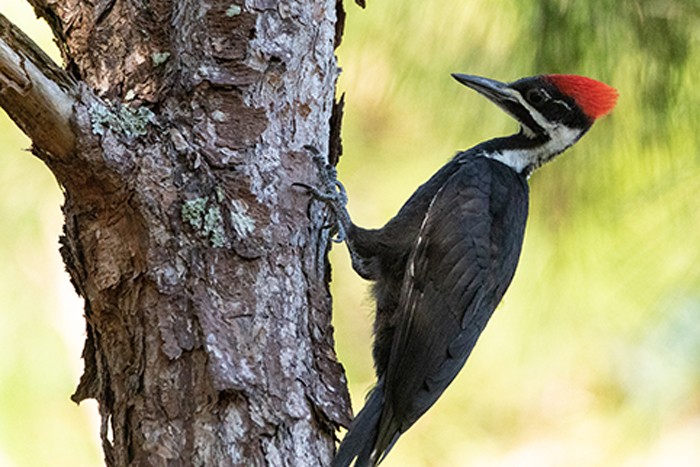Introducing the Secrets of Woodpeckers: Habits, Environment, and More
Woodpeckers, with their unique actions and specialized adaptations, have actually lengthy attracted researchers and nature lovers alike. By revealing the mysteries surrounding woodpeckers' habits and habitat options, a much deeper understanding of these bird marvels emerges, using a glimpse right into their remarkable world.
Woodpecker Habits Insights
In taking a look at woodpecker actions, a fascinating display screen of specialized skills and adjustments emerges, clarifying their impressive eco-friendly particular niche - Woodpeckers in Florida. Woodpeckers, understood for their distinctive drumming on trees, have a range of behavioral attributes that add to their survival and success in their environment. One key actions is their drumming, which serves multiple functions such as communication, establishing territory, bring in companions, and situating food resources. This balanced pecking also showcases their exceptional toughness and endurance, as they can hammer away constantly at high speeds without triggering injury to themselves.
In addition, woodpeckers exhibit an unique feeding behavior identified by their capacity to essence insects from tree bark utilizing their specialized beaks. Their lengthy, barbed tongues aid in recording target, while their strong neck muscle mass provide stability and accuracy throughout pecking movements. This feeding method allows woodpeckers to access concealed insect larvae and extract them with impressive effectiveness.
Environment Preferences and Choice
What variables influence the habitat preferences and selection of woodpeckers? Woodpeckers are highly adaptable birds understood to inhabit numerous environments worldwide. They do exhibit choices for specific habitat characteristics. One crucial aspect influencing woodpecker habitat choice is the accessibility of ideal nesting sites. Woodpeckers usually like woodlands with a mix of fully grown trees that provide ample opportunities for dental caries excavation. These cavities offer as important nesting and roosting sites for woodpeckers and are important for their reproducing success.
Additionally, woodpeckers show a choice for environments with a plentiful supply of food resources. They are largely insectivorous, eating beetles, ants, larvae, and various other insects discovered in rotting wood or tree bark. Therefore, woodpeckers have a tendency to favor wooded locations with a varied insect populace to fulfill their nutritional demands.
Additionally, the visibility of dead or rotting trees is another key consider woodpecker environment choice. These trees not just offer food resources yet additionally supply ideal substrate for cavity excavation. Dead trees are crucial for the maintenance of healthy woodpecker populations, as they play an important duty in the woodpeckers' life process and ecosystem dynamics.
Feeding Practices and Diet Regimen Composition
Woodpeckers show a specialized feeding actions focused on foraging for bugs within different habitats. In enhancement to bugs, woodpeckers likewise take in tree sap, fruits, nuts, and seeds, including range to their diet plan depending on the season and availability of food resources.
The foraging strategies of woodpeckers are well-adapted to their arboreal way of life (Woodpeckers in Florida). Their capacity to dig deep into wood not only gives them with food yet likewise aids in developing nesting tooth cavities and developing territories. Woodpeckers play a vital role in keeping the wellness of woodlands by controlling insect populations and helping in the decomposition of timber. Recognizing their feeding this link habits and diet regimen make-up is essential for conservation initiatives targeted at protecting these special and valuable birds.
Drumming Seems and Interaction
Using quick drumming sounds on numerous surface areas, woodpeckers employ an unique form of interaction to signal region limits and attract friends. This drumming behavior is not only a method of interaction yet likewise acts use this link as a means for woodpeckers to develop their presence within a certain location. The intensity, speed, and pattern of the drumming can convey essential details to other woodpeckers around.
Woodpeckers make use of drumming audios to reveal their presence in an area and to alert off potential burglars. The loud and repeated nature of the drumming works as a clear signal to various other woodpeckers that the area is currently claimed. This helps in reducing problems and lessening physical fights in between people.

Survival Adaptations and Specialized Makeup

Final Thought
To conclude, woodpeckers exhibit distinct behaviors, such as drumming noises for interaction, and have specialized composition for survival in their chosen environments. Their feeding habits and diet composition further show their adaptability to different settings. By recognizing these aspects of woodpeckers, researchers and guardians can better secure and maintain these remarkable birds and their ecosystems.